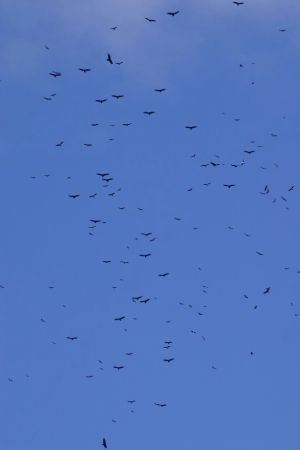 No, I don’t mean pots and pans. I’m talking about hawks.
No, I don’t mean pots and pans. I’m talking about hawks.
Hawks form “kettles” in thermal updrafts during migration. When they find a column of warm, rising air they stretch out their wings to rise with it. Other hawks see the kettle forming and join the crowd. The kettle grows and grows.
As each hawk reaches altitude at the top of the thermal he sets his wings and glides away toward his destination. One by one, birds leave the kettle from the top while others join below. During their glide hawks lose altitude so they find another thermal and repeat the process. Perhaps this “boiling” action is why it’s called a kettle.
Kettling saves energy because the hawks rarely have to flap. They also save by migrating along mountain ridges with the wind at their backs. For that reason hawk watches are located on ridge tops, the most famous being Hawk Mountain in Schuylkill County, Pennsylvania.
Broad-winged hawks are the champions of kettling. Last week was the peak of their migration through Pennsylvania and you can see it in the hawk watch numbers. Take, for instance, these three locations on September 16th: 1,169 hawks reported at Buckingham, 2,905 at Militia Hill, and 2,005 at Rose-Tree Park in Media. These hawk watches are located in a straight line as the bird flies. If you’d had a way to mark a group of birds you could probably compute their ground speed using hawk watch records.
Some days are better than others. The next day (September 17) Buckingham counted 7,512 raptors.
And some places are just plain stupendous. Veracruz, Mexico saw 66,223 raptors fly by yesterday. 64,917 of them were broad-winged hawks – and they haven’t reached their peak yet!
The miracle of the Veracruz “River of Raptors” is an accident of geography. By the time broad-winged hawks reach Veracruz on their way to South America, their entire population is concentrated in a narrow flyway along the Gulf Coast. The kettles there contain thousands and thousands of birds – broad-wings, turkey vultures and others – as pictured here at Cardel, Mexico by the Powdermill Avian Research staff in October 2006.
I remember the thrill of seeing small kettles at the Cadillac Mountain Hawk Watch this year. Some day I hope to see the huge kettles… but it will have to wait until I have time to make the trip.
p.s. For daily reports and monthly summaries of hawk counts in North America, see the Hawkcount website.
(Thanks to Bob Mulvihill for providing this photo from Powdermill Avian Research. Click on the photo to read about their trip to the 2006 NAOC conference and Cardel, Mexico.)
Thank you for that wonderful explantion. We were wondering what the antonym for kettling was.